Essay on Organizational Communication: More Than Information
VerifiedAdded on 2021/06/15
|11
|2933
|98
Essay
AI Summary
This essay critically examines the multifaceted role of organizational communication, arguing that it extends far beyond a mere exchange of operational data. It explores how effective communication is fundamental to all core management functions, including planning, leading, organizing, and controlling, within both local and global markets. The essay highlights the importance of communication in motivating employees, shaping attitudes, and fostering social interaction among stakeholders. It also delves into the various types of organizational communication, such as verbal, written, and electronic, and discusses how advanced communication strategies are essential for maintaining a positive public image. Furthermore, the essay emphasizes the role of communication in controlling employee behavior, fostering motivation, and ultimately, contributing to the overall success of an organization. The analysis also points out the potential negative consequences of communication failures, such as employee stress and decreased organizational commitment. In conclusion, the essay underscores the crucial role of communication in the modern business landscape.
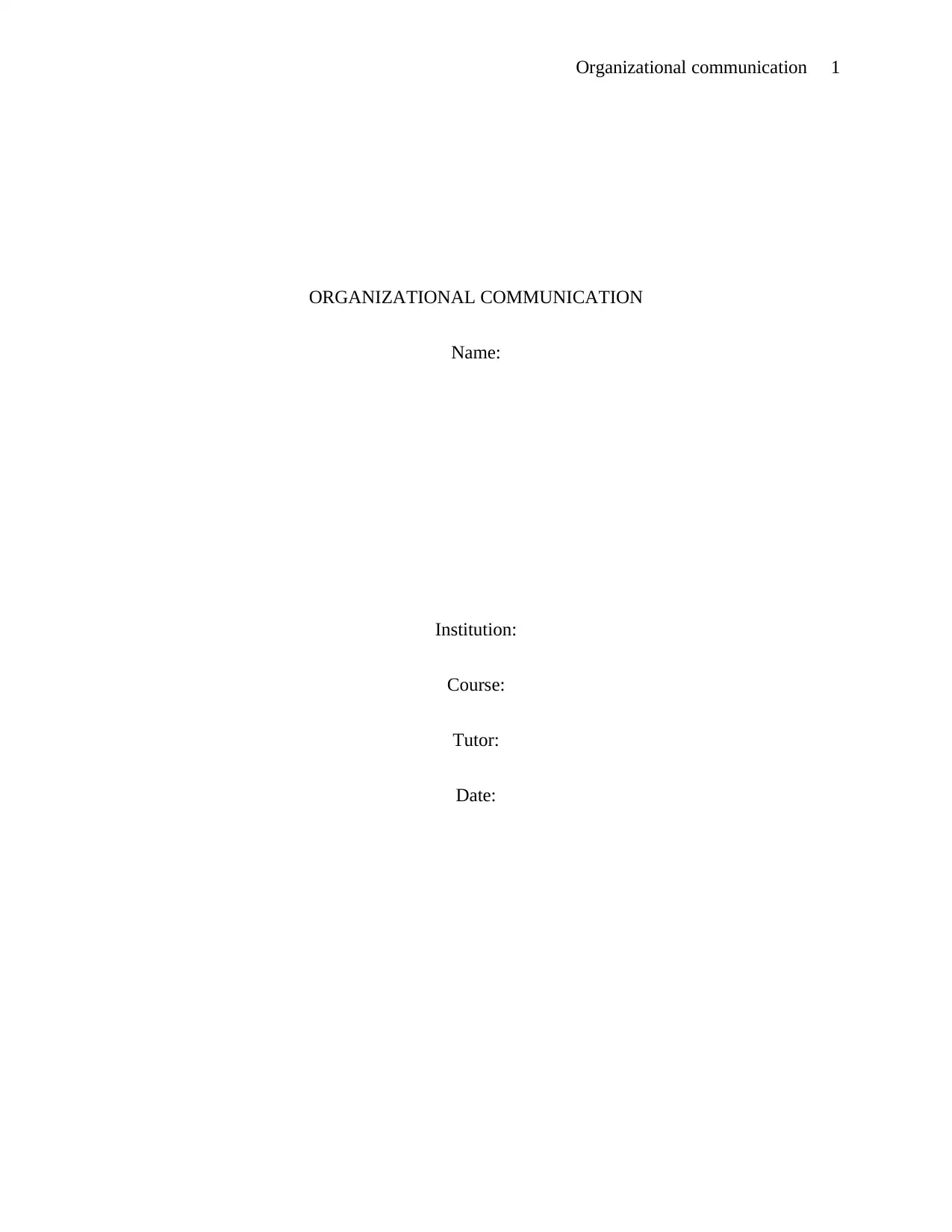
Organizational communication 1
ORGANIZATIONAL COMMUNICATION
Name:
Institution:
Course:
Tutor:
Date:
ORGANIZATIONAL COMMUNICATION
Name:
Institution:
Course:
Tutor:
Date:
Secure Best Marks with AI Grader
Need help grading? Try our AI Grader for instant feedback on your assignments.
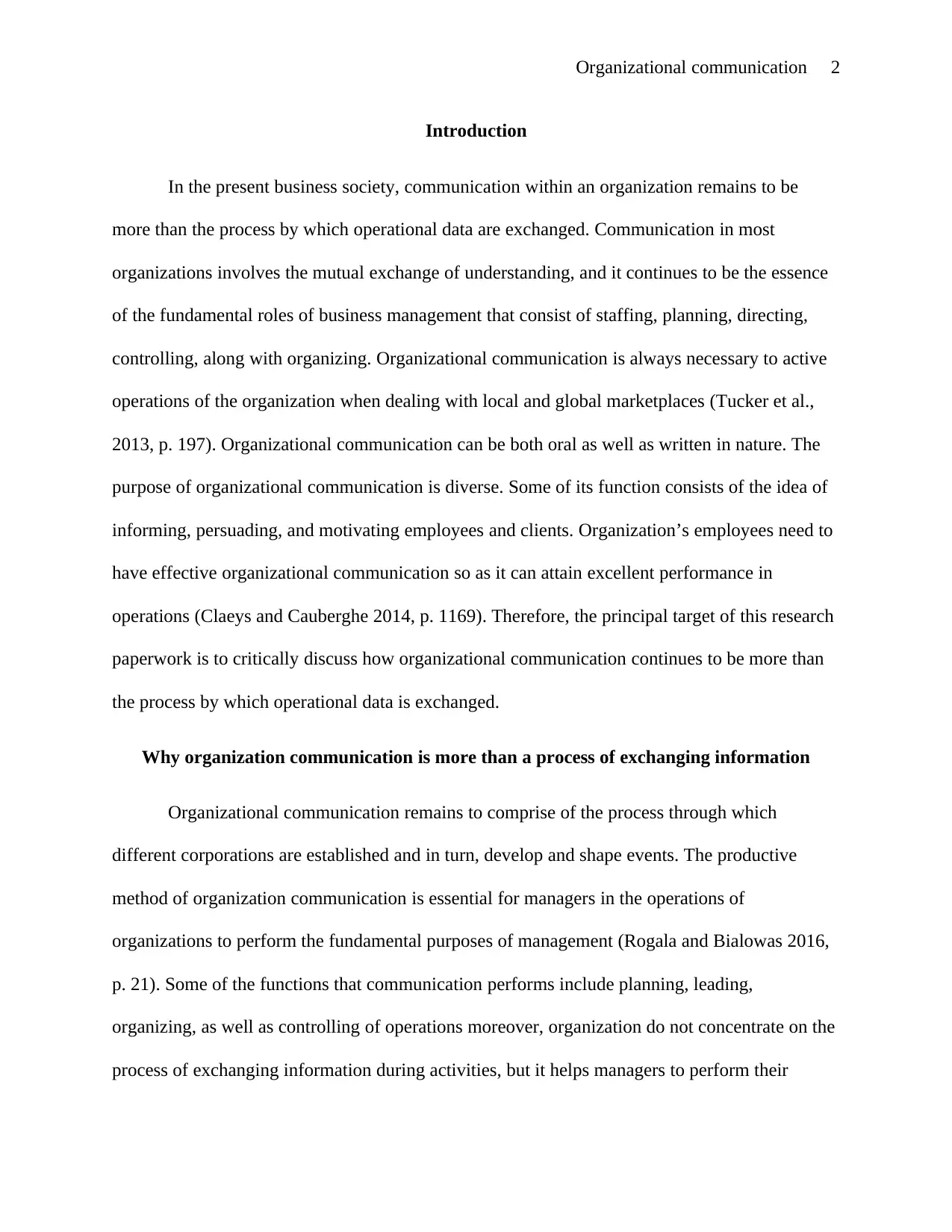
Organizational communication 2
Introduction
In the present business society, communication within an organization remains to be
more than the process by which operational data are exchanged. Communication in most
organizations involves the mutual exchange of understanding, and it continues to be the essence
of the fundamental roles of business management that consist of staffing, planning, directing,
controlling, along with organizing. Organizational communication is always necessary to active
operations of the organization when dealing with local and global marketplaces (Tucker et al.,
2013, p. 197). Organizational communication can be both oral as well as written in nature. The
purpose of organizational communication is diverse. Some of its function consists of the idea of
informing, persuading, and motivating employees and clients. Organization’s employees need to
have effective organizational communication so as it can attain excellent performance in
operations (Claeys and Cauberghe 2014, p. 1169). Therefore, the principal target of this research
paperwork is to critically discuss how organizational communication continues to be more than
the process by which operational data is exchanged.
Why organization communication is more than a process of exchanging information
Organizational communication remains to comprise of the process through which
different corporations are established and in turn, develop and shape events. The productive
method of organization communication is essential for managers in the operations of
organizations to perform the fundamental purposes of management (Rogala and Bialowas 2016,
p. 21). Some of the functions that communication performs include planning, leading,
organizing, as well as controlling of operations moreover, organization do not concentrate on the
process of exchanging information during activities, but it helps managers to perform their
Introduction
In the present business society, communication within an organization remains to be
more than the process by which operational data are exchanged. Communication in most
organizations involves the mutual exchange of understanding, and it continues to be the essence
of the fundamental roles of business management that consist of staffing, planning, directing,
controlling, along with organizing. Organizational communication is always necessary to active
operations of the organization when dealing with local and global marketplaces (Tucker et al.,
2013, p. 197). Organizational communication can be both oral as well as written in nature. The
purpose of organizational communication is diverse. Some of its function consists of the idea of
informing, persuading, and motivating employees and clients. Organization’s employees need to
have effective organizational communication so as it can attain excellent performance in
operations (Claeys and Cauberghe 2014, p. 1169). Therefore, the principal target of this research
paperwork is to critically discuss how organizational communication continues to be more than
the process by which operational data is exchanged.
Why organization communication is more than a process of exchanging information
Organizational communication remains to comprise of the process through which
different corporations are established and in turn, develop and shape events. The productive
method of organization communication is essential for managers in the operations of
organizations to perform the fundamental purposes of management (Rogala and Bialowas 2016,
p. 21). Some of the functions that communication performs include planning, leading,
organizing, as well as controlling of operations moreover, organization do not concentrate on the
process of exchanging information during activities, but it helps managers to perform their
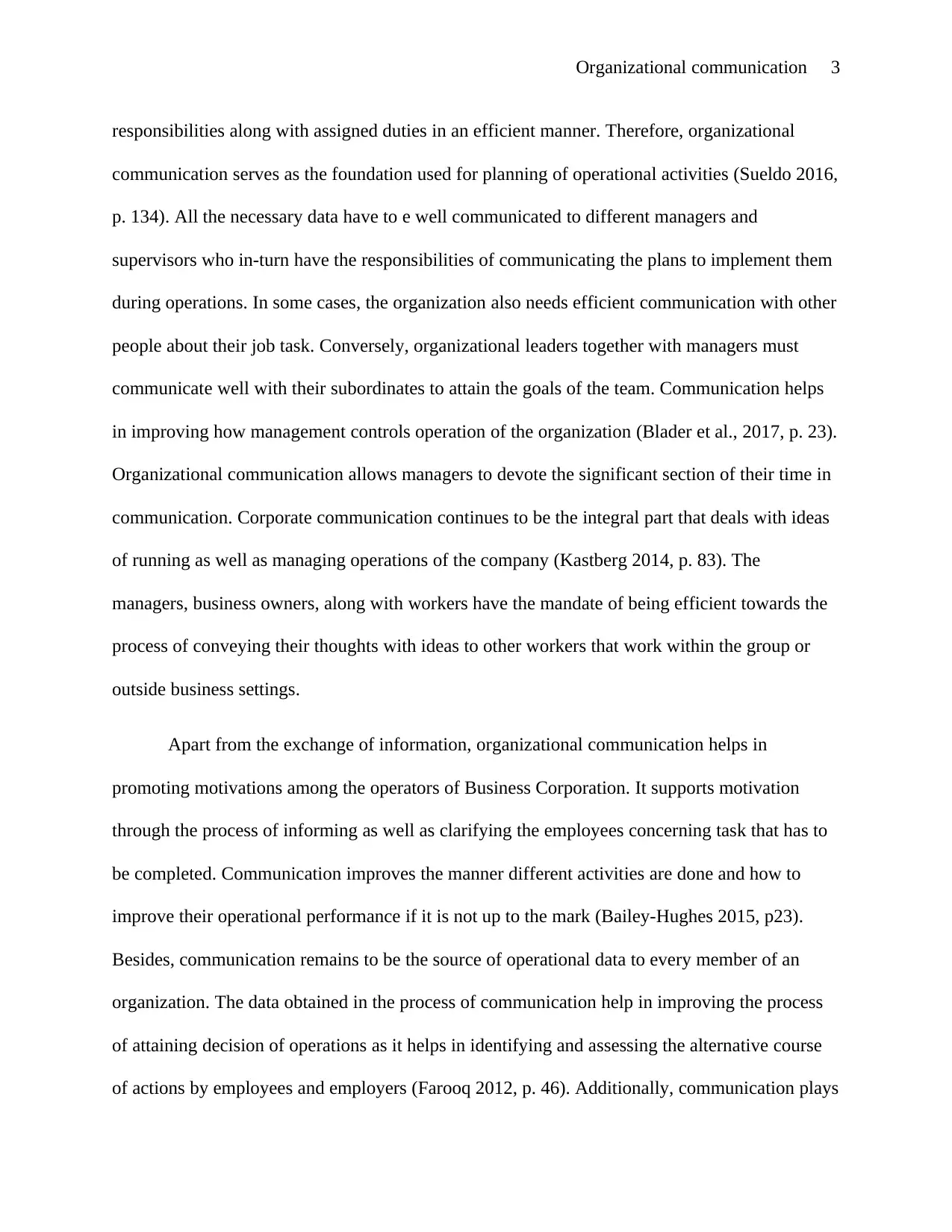
Organizational communication 3
responsibilities along with assigned duties in an efficient manner. Therefore, organizational
communication serves as the foundation used for planning of operational activities (Sueldo 2016,
p. 134). All the necessary data have to e well communicated to different managers and
supervisors who in-turn have the responsibilities of communicating the plans to implement them
during operations. In some cases, the organization also needs efficient communication with other
people about their job task. Conversely, organizational leaders together with managers must
communicate well with their subordinates to attain the goals of the team. Communication helps
in improving how management controls operation of the organization (Blader et al., 2017, p. 23).
Organizational communication allows managers to devote the significant section of their time in
communication. Corporate communication continues to be the integral part that deals with ideas
of running as well as managing operations of the company (Kastberg 2014, p. 83). The
managers, business owners, along with workers have the mandate of being efficient towards the
process of conveying their thoughts with ideas to other workers that work within the group or
outside business settings.
Apart from the exchange of information, organizational communication helps in
promoting motivations among the operators of Business Corporation. It supports motivation
through the process of informing as well as clarifying the employees concerning task that has to
be completed. Communication improves the manner different activities are done and how to
improve their operational performance if it is not up to the mark (Bailey-Hughes 2015, p23).
Besides, communication remains to be the source of operational data to every member of an
organization. The data obtained in the process of communication help in improving the process
of attaining decision of operations as it helps in identifying and assessing the alternative course
of actions by employees and employers (Farooq 2012, p. 46). Additionally, communication plays
responsibilities along with assigned duties in an efficient manner. Therefore, organizational
communication serves as the foundation used for planning of operational activities (Sueldo 2016,
p. 134). All the necessary data have to e well communicated to different managers and
supervisors who in-turn have the responsibilities of communicating the plans to implement them
during operations. In some cases, the organization also needs efficient communication with other
people about their job task. Conversely, organizational leaders together with managers must
communicate well with their subordinates to attain the goals of the team. Communication helps
in improving how management controls operation of the organization (Blader et al., 2017, p. 23).
Organizational communication allows managers to devote the significant section of their time in
communication. Corporate communication continues to be the integral part that deals with ideas
of running as well as managing operations of the company (Kastberg 2014, p. 83). The
managers, business owners, along with workers have the mandate of being efficient towards the
process of conveying their thoughts with ideas to other workers that work within the group or
outside business settings.
Apart from the exchange of information, organizational communication helps in
promoting motivations among the operators of Business Corporation. It supports motivation
through the process of informing as well as clarifying the employees concerning task that has to
be completed. Communication improves the manner different activities are done and how to
improve their operational performance if it is not up to the mark (Bailey-Hughes 2015, p23).
Besides, communication remains to be the source of operational data to every member of an
organization. The data obtained in the process of communication help in improving the process
of attaining decision of operations as it helps in identifying and assessing the alternative course
of actions by employees and employers (Farooq 2012, p. 46). Additionally, communication plays
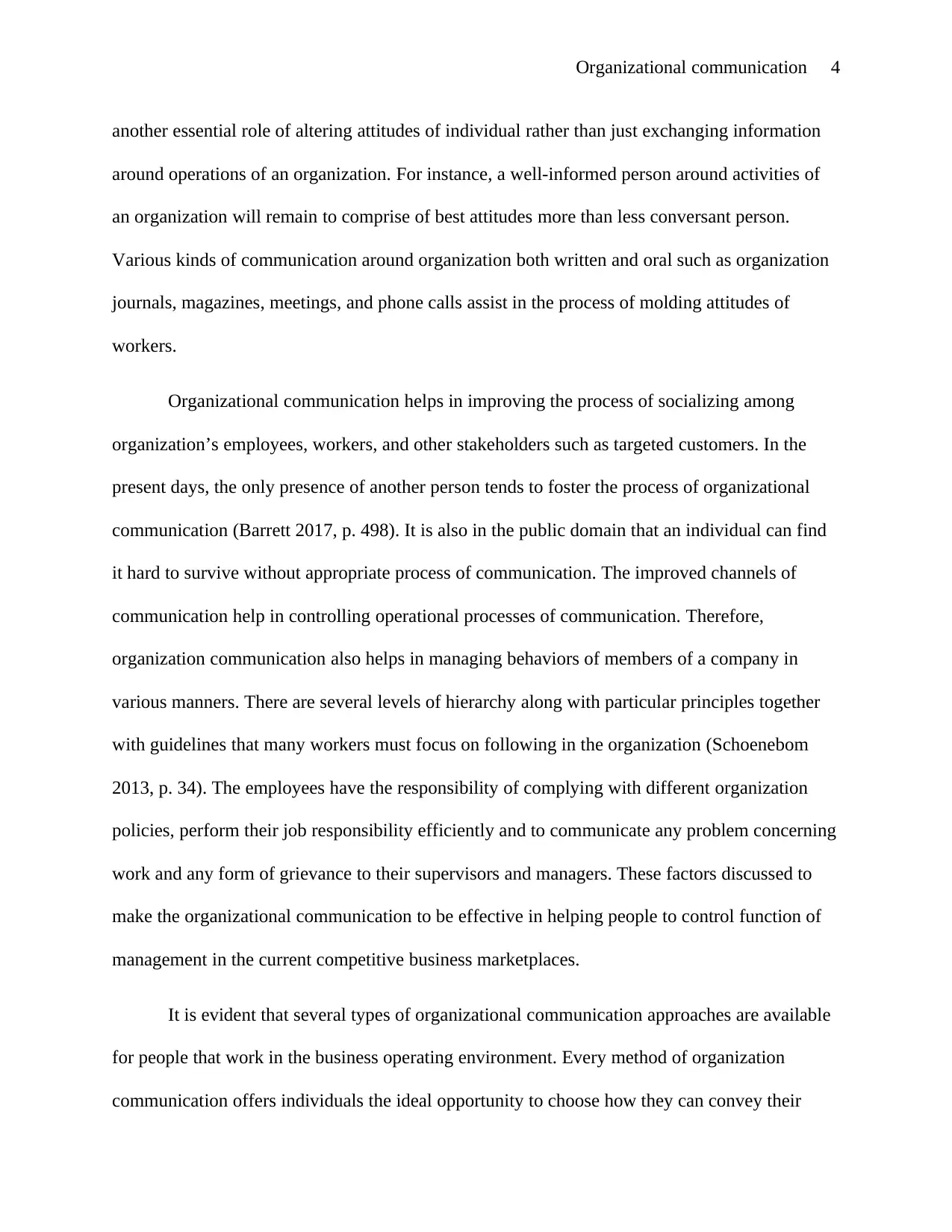
Organizational communication 4
another essential role of altering attitudes of individual rather than just exchanging information
around operations of an organization. For instance, a well-informed person around activities of
an organization will remain to comprise of best attitudes more than less conversant person.
Various kinds of communication around organization both written and oral such as organization
journals, magazines, meetings, and phone calls assist in the process of molding attitudes of
workers.
Organizational communication helps in improving the process of socializing among
organization’s employees, workers, and other stakeholders such as targeted customers. In the
present days, the only presence of another person tends to foster the process of organizational
communication (Barrett 2017, p. 498). It is also in the public domain that an individual can find
it hard to survive without appropriate process of communication. The improved channels of
communication help in controlling operational processes of communication. Therefore,
organization communication also helps in managing behaviors of members of a company in
various manners. There are several levels of hierarchy along with particular principles together
with guidelines that many workers must focus on following in the organization (Schoenebom
2013, p. 34). The employees have the responsibility of complying with different organization
policies, perform their job responsibility efficiently and to communicate any problem concerning
work and any form of grievance to their supervisors and managers. These factors discussed to
make the organizational communication to be effective in helping people to control function of
management in the current competitive business marketplaces.
It is evident that several types of organizational communication approaches are available
for people that work in the business operating environment. Every method of organization
communication offers individuals the ideal opportunity to choose how they can convey their
another essential role of altering attitudes of individual rather than just exchanging information
around operations of an organization. For instance, a well-informed person around activities of
an organization will remain to comprise of best attitudes more than less conversant person.
Various kinds of communication around organization both written and oral such as organization
journals, magazines, meetings, and phone calls assist in the process of molding attitudes of
workers.
Organizational communication helps in improving the process of socializing among
organization’s employees, workers, and other stakeholders such as targeted customers. In the
present days, the only presence of another person tends to foster the process of organizational
communication (Barrett 2017, p. 498). It is also in the public domain that an individual can find
it hard to survive without appropriate process of communication. The improved channels of
communication help in controlling operational processes of communication. Therefore,
organization communication also helps in managing behaviors of members of a company in
various manners. There are several levels of hierarchy along with particular principles together
with guidelines that many workers must focus on following in the organization (Schoenebom
2013, p. 34). The employees have the responsibility of complying with different organization
policies, perform their job responsibility efficiently and to communicate any problem concerning
work and any form of grievance to their supervisors and managers. These factors discussed to
make the organizational communication to be effective in helping people to control function of
management in the current competitive business marketplaces.
It is evident that several types of organizational communication approaches are available
for people that work in the business operating environment. Every method of organization
communication offers individuals the ideal opportunity to choose how they can convey their
Secure Best Marks with AI Grader
Need help grading? Try our AI Grader for instant feedback on your assignments.
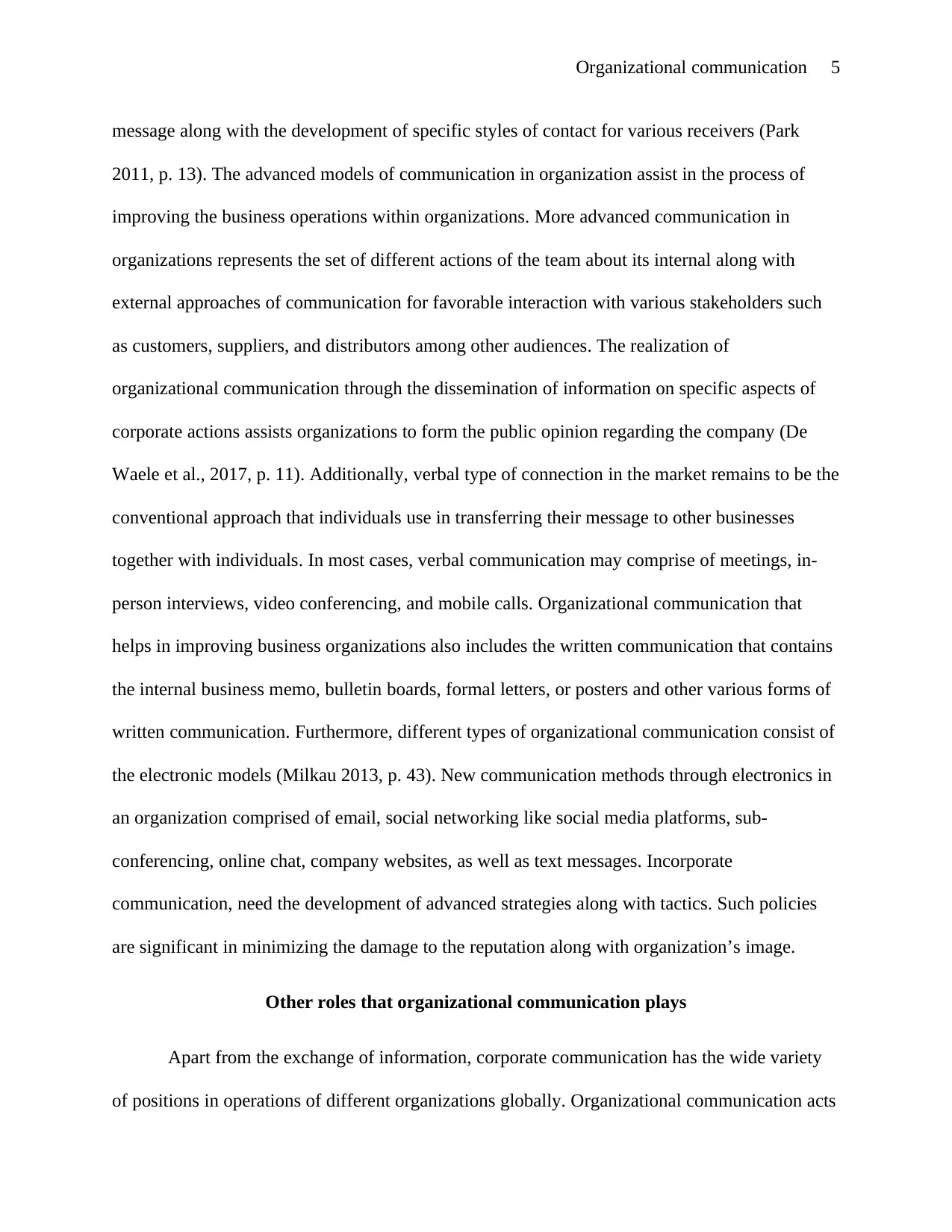
Organizational communication 5
message along with the development of specific styles of contact for various receivers (Park
2011, p. 13). The advanced models of communication in organization assist in the process of
improving the business operations within organizations. More advanced communication in
organizations represents the set of different actions of the team about its internal along with
external approaches of communication for favorable interaction with various stakeholders such
as customers, suppliers, and distributors among other audiences. The realization of
organizational communication through the dissemination of information on specific aspects of
corporate actions assists organizations to form the public opinion regarding the company (De
Waele et al., 2017, p. 11). Additionally, verbal type of connection in the market remains to be the
conventional approach that individuals use in transferring their message to other businesses
together with individuals. In most cases, verbal communication may comprise of meetings, in-
person interviews, video conferencing, and mobile calls. Organizational communication that
helps in improving business organizations also includes the written communication that contains
the internal business memo, bulletin boards, formal letters, or posters and other various forms of
written communication. Furthermore, different types of organizational communication consist of
the electronic models (Milkau 2013, p. 43). New communication methods through electronics in
an organization comprised of email, social networking like social media platforms, sub-
conferencing, online chat, company websites, as well as text messages. Incorporate
communication, need the development of advanced strategies along with tactics. Such policies
are significant in minimizing the damage to the reputation along with organization’s image.
Other roles that organizational communication plays
Apart from the exchange of information, corporate communication has the wide variety
of positions in operations of different organizations globally. Organizational communication acts
message along with the development of specific styles of contact for various receivers (Park
2011, p. 13). The advanced models of communication in organization assist in the process of
improving the business operations within organizations. More advanced communication in
organizations represents the set of different actions of the team about its internal along with
external approaches of communication for favorable interaction with various stakeholders such
as customers, suppliers, and distributors among other audiences. The realization of
organizational communication through the dissemination of information on specific aspects of
corporate actions assists organizations to form the public opinion regarding the company (De
Waele et al., 2017, p. 11). Additionally, verbal type of connection in the market remains to be the
conventional approach that individuals use in transferring their message to other businesses
together with individuals. In most cases, verbal communication may comprise of meetings, in-
person interviews, video conferencing, and mobile calls. Organizational communication that
helps in improving business organizations also includes the written communication that contains
the internal business memo, bulletin boards, formal letters, or posters and other various forms of
written communication. Furthermore, different types of organizational communication consist of
the electronic models (Milkau 2013, p. 43). New communication methods through electronics in
an organization comprised of email, social networking like social media platforms, sub-
conferencing, online chat, company websites, as well as text messages. Incorporate
communication, need the development of advanced strategies along with tactics. Such policies
are significant in minimizing the damage to the reputation along with organization’s image.
Other roles that organizational communication plays
Apart from the exchange of information, corporate communication has the wide variety
of positions in operations of different organizations globally. Organizational communication acts
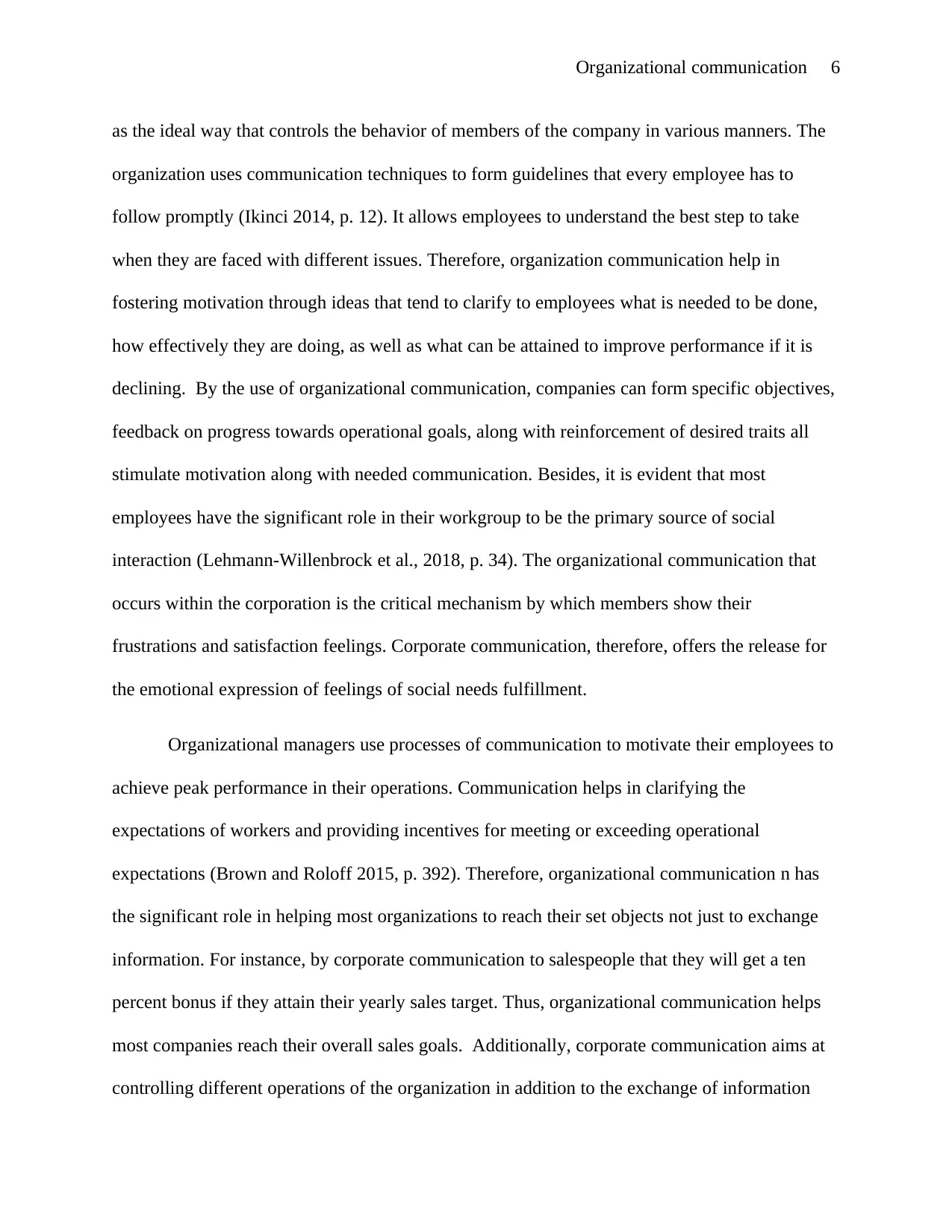
Organizational communication 6
as the ideal way that controls the behavior of members of the company in various manners. The
organization uses communication techniques to form guidelines that every employee has to
follow promptly (Ikinci 2014, p. 12). It allows employees to understand the best step to take
when they are faced with different issues. Therefore, organization communication help in
fostering motivation through ideas that tend to clarify to employees what is needed to be done,
how effectively they are doing, as well as what can be attained to improve performance if it is
declining. By the use of organizational communication, companies can form specific objectives,
feedback on progress towards operational goals, along with reinforcement of desired traits all
stimulate motivation along with needed communication. Besides, it is evident that most
employees have the significant role in their workgroup to be the primary source of social
interaction (Lehmann-Willenbrock et al., 2018, p. 34). The organizational communication that
occurs within the corporation is the critical mechanism by which members show their
frustrations and satisfaction feelings. Corporate communication, therefore, offers the release for
the emotional expression of feelings of social needs fulfillment.
Organizational managers use processes of communication to motivate their employees to
achieve peak performance in their operations. Communication helps in clarifying the
expectations of workers and providing incentives for meeting or exceeding operational
expectations (Brown and Roloff 2015, p. 392). Therefore, organizational communication n has
the significant role in helping most organizations to reach their set objects not just to exchange
information. For instance, by corporate communication to salespeople that they will get a ten
percent bonus if they attain their yearly sales target. Thus, organizational communication helps
most companies reach their overall sales goals. Additionally, corporate communication aims at
controlling different operations of the organization in addition to the exchange of information
as the ideal way that controls the behavior of members of the company in various manners. The
organization uses communication techniques to form guidelines that every employee has to
follow promptly (Ikinci 2014, p. 12). It allows employees to understand the best step to take
when they are faced with different issues. Therefore, organization communication help in
fostering motivation through ideas that tend to clarify to employees what is needed to be done,
how effectively they are doing, as well as what can be attained to improve performance if it is
declining. By the use of organizational communication, companies can form specific objectives,
feedback on progress towards operational goals, along with reinforcement of desired traits all
stimulate motivation along with needed communication. Besides, it is evident that most
employees have the significant role in their workgroup to be the primary source of social
interaction (Lehmann-Willenbrock et al., 2018, p. 34). The organizational communication that
occurs within the corporation is the critical mechanism by which members show their
frustrations and satisfaction feelings. Corporate communication, therefore, offers the release for
the emotional expression of feelings of social needs fulfillment.
Organizational managers use processes of communication to motivate their employees to
achieve peak performance in their operations. Communication helps in clarifying the
expectations of workers and providing incentives for meeting or exceeding operational
expectations (Brown and Roloff 2015, p. 392). Therefore, organizational communication n has
the significant role in helping most organizations to reach their set objects not just to exchange
information. For instance, by corporate communication to salespeople that they will get a ten
percent bonus if they attain their yearly sales target. Thus, organizational communication helps
most companies reach their overall sales goals. Additionally, corporate communication aims at
controlling different operations of the organization in addition to the exchange of information
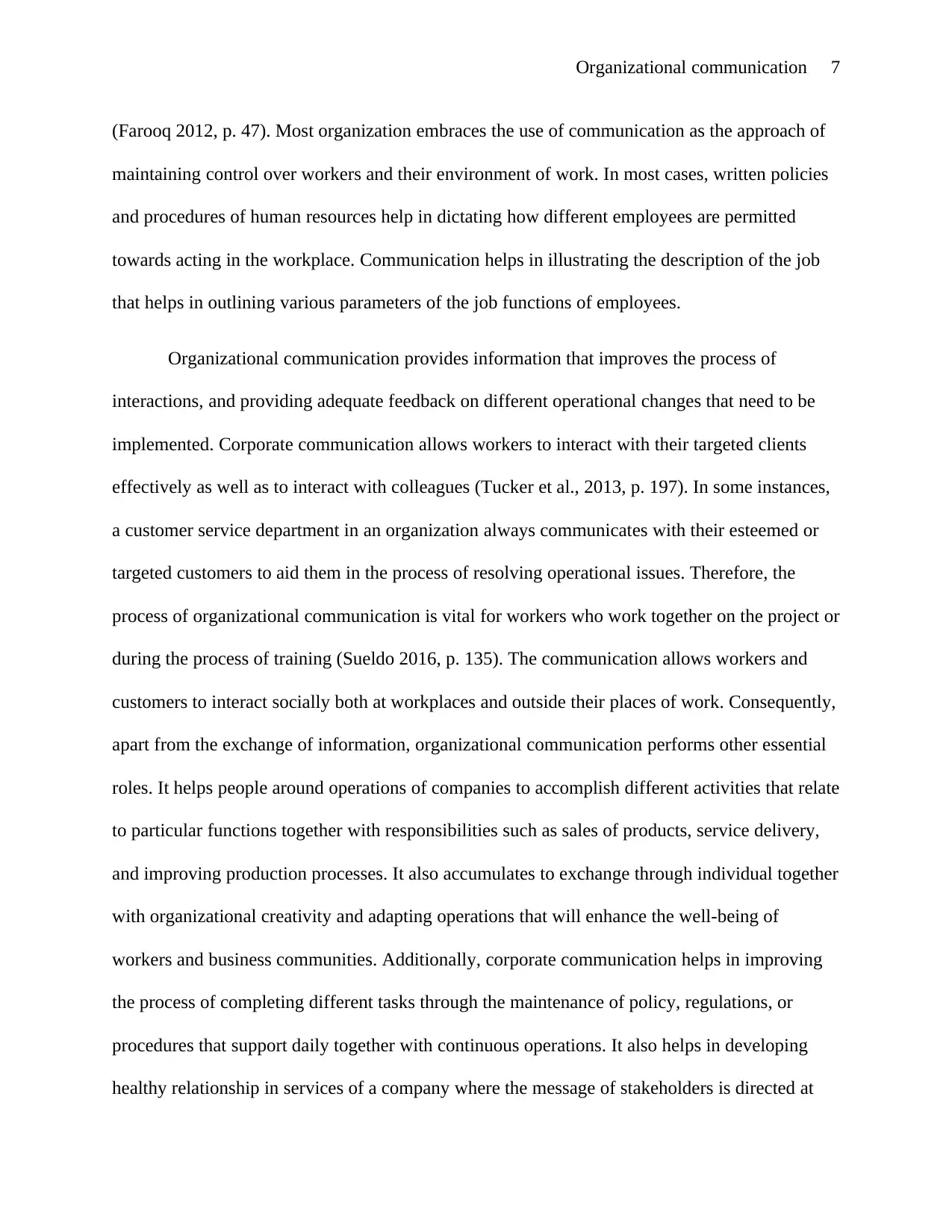
Organizational communication 7
(Farooq 2012, p. 47). Most organization embraces the use of communication as the approach of
maintaining control over workers and their environment of work. In most cases, written policies
and procedures of human resources help in dictating how different employees are permitted
towards acting in the workplace. Communication helps in illustrating the description of the job
that helps in outlining various parameters of the job functions of employees.
Organizational communication provides information that improves the process of
interactions, and providing adequate feedback on different operational changes that need to be
implemented. Corporate communication allows workers to interact with their targeted clients
effectively as well as to interact with colleagues (Tucker et al., 2013, p. 197). In some instances,
a customer service department in an organization always communicates with their esteemed or
targeted customers to aid them in the process of resolving operational issues. Therefore, the
process of organizational communication is vital for workers who work together on the project or
during the process of training (Sueldo 2016, p. 135). The communication allows workers and
customers to interact socially both at workplaces and outside their places of work. Consequently,
apart from the exchange of information, organizational communication performs other essential
roles. It helps people around operations of companies to accomplish different activities that relate
to particular functions together with responsibilities such as sales of products, service delivery,
and improving production processes. It also accumulates to exchange through individual together
with organizational creativity and adapting operations that will enhance the well-being of
workers and business communities. Additionally, corporate communication helps in improving
the process of completing different tasks through the maintenance of policy, regulations, or
procedures that support daily together with continuous operations. It also helps in developing
healthy relationship in services of a company where the message of stakeholders is directed at
(Farooq 2012, p. 47). Most organization embraces the use of communication as the approach of
maintaining control over workers and their environment of work. In most cases, written policies
and procedures of human resources help in dictating how different employees are permitted
towards acting in the workplace. Communication helps in illustrating the description of the job
that helps in outlining various parameters of the job functions of employees.
Organizational communication provides information that improves the process of
interactions, and providing adequate feedback on different operational changes that need to be
implemented. Corporate communication allows workers to interact with their targeted clients
effectively as well as to interact with colleagues (Tucker et al., 2013, p. 197). In some instances,
a customer service department in an organization always communicates with their esteemed or
targeted customers to aid them in the process of resolving operational issues. Therefore, the
process of organizational communication is vital for workers who work together on the project or
during the process of training (Sueldo 2016, p. 135). The communication allows workers and
customers to interact socially both at workplaces and outside their places of work. Consequently,
apart from the exchange of information, organizational communication performs other essential
roles. It helps people around operations of companies to accomplish different activities that relate
to particular functions together with responsibilities such as sales of products, service delivery,
and improving production processes. It also accumulates to exchange through individual together
with organizational creativity and adapting operations that will enhance the well-being of
workers and business communities. Additionally, corporate communication helps in improving
the process of completing different tasks through the maintenance of policy, regulations, or
procedures that support daily together with continuous operations. It also helps in developing
healthy relationship in services of a company where the message of stakeholders is directed at
Paraphrase This Document
Need a fresh take? Get an instant paraphrase of this document with our AI Paraphraser

Organizational communication 8
people within the company. It comprises of improving the relationship on signals of human that
consist of their attitudes, morale, satisfaction, together with fulfillment (Rogala and Bialowas
2016, p. 32). Therefore, organization communication remains to relate with how organizations
represent, constitute, as well as present their climate and culture of the organization regarding
values, attitudes, and goals that characterize the organization activities and its members.
The practical process of organizational communication helps in simplifying the success
of operations of the organization. Various surveys have reported that communication process
comprises of positive correlation with different corporate output such as commitment to
organization, performance, the behavior of organization citizenship, along with the satisfaction
of job opportunities (De Waele et al., 2017, p. 127). However, failure of organizational
communication may result to functionless outcomes that comprise of stress among employees,
the dissatisfaction of job, low trust, the decline in the commitment of organization, low trust
among organization stakeholders, decline in commitment towards organization operations,
severance intention, along with the absence of employees. All these adverse effects of
organizational communication can have the adverse impact on the efficiency of the organization.
Therefore, in present business society, corporate communication remains as an essential
component of activities and operations of companies (Brown and Roloff 2015, p. 401). It is
necessary component since global marketplaces have become widespread making it necessary
for most or organization to concentrate on meeting their needs with lower resources oblige to
recruit organizational communication and lower failure in communication.
Conclusion
people within the company. It comprises of improving the relationship on signals of human that
consist of their attitudes, morale, satisfaction, together with fulfillment (Rogala and Bialowas
2016, p. 32). Therefore, organization communication remains to relate with how organizations
represent, constitute, as well as present their climate and culture of the organization regarding
values, attitudes, and goals that characterize the organization activities and its members.
The practical process of organizational communication helps in simplifying the success
of operations of the organization. Various surveys have reported that communication process
comprises of positive correlation with different corporate output such as commitment to
organization, performance, the behavior of organization citizenship, along with the satisfaction
of job opportunities (De Waele et al., 2017, p. 127). However, failure of organizational
communication may result to functionless outcomes that comprise of stress among employees,
the dissatisfaction of job, low trust, the decline in the commitment of organization, low trust
among organization stakeholders, decline in commitment towards organization operations,
severance intention, along with the absence of employees. All these adverse effects of
organizational communication can have the adverse impact on the efficiency of the organization.
Therefore, in present business society, corporate communication remains as an essential
component of activities and operations of companies (Brown and Roloff 2015, p. 401). It is
necessary component since global marketplaces have become widespread making it necessary
for most or organization to concentrate on meeting their needs with lower resources oblige to
recruit organizational communication and lower failure in communication.
Conclusion
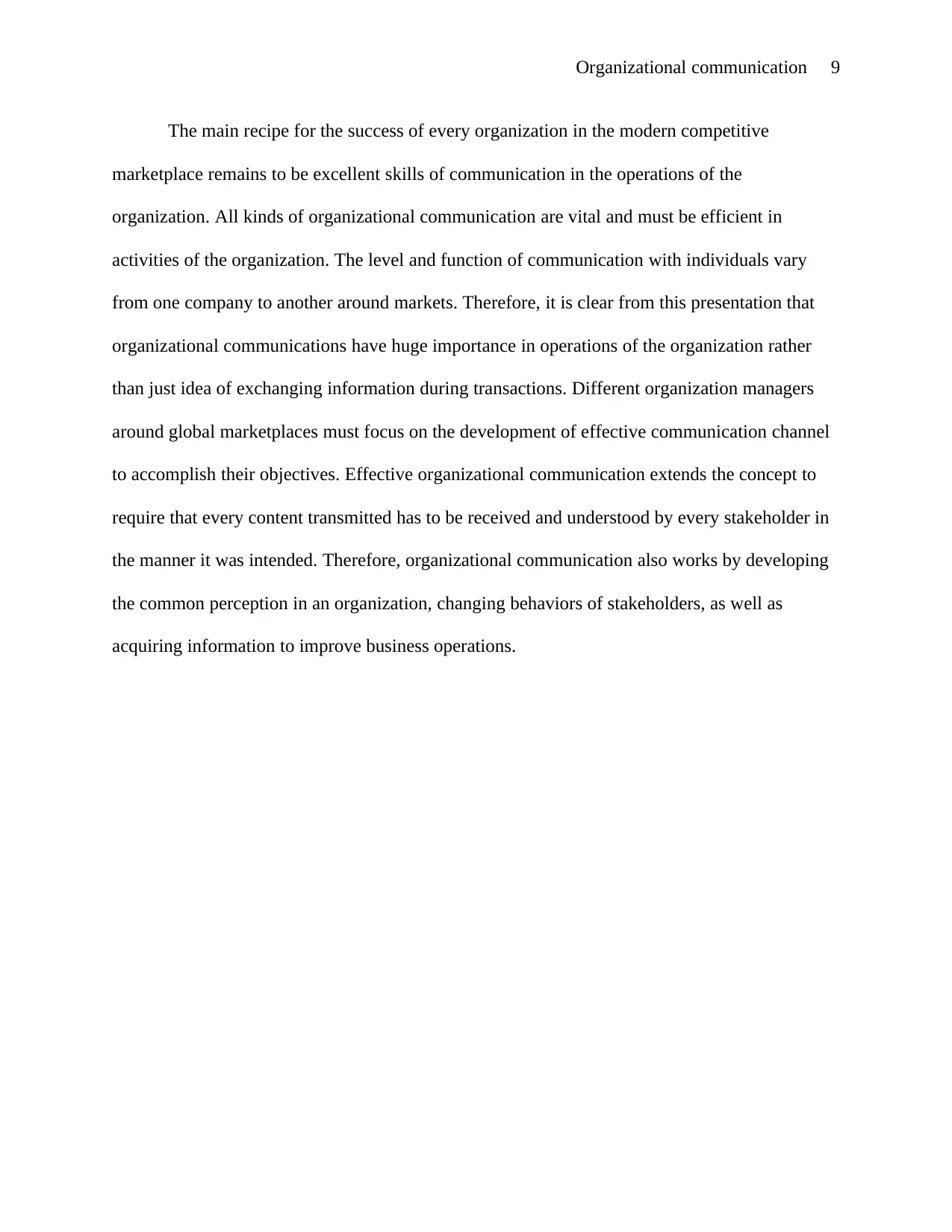
Organizational communication 9
The main recipe for the success of every organization in the modern competitive
marketplace remains to be excellent skills of communication in the operations of the
organization. All kinds of organizational communication are vital and must be efficient in
activities of the organization. The level and function of communication with individuals vary
from one company to another around markets. Therefore, it is clear from this presentation that
organizational communications have huge importance in operations of the organization rather
than just idea of exchanging information during transactions. Different organization managers
around global marketplaces must focus on the development of effective communication channel
to accomplish their objectives. Effective organizational communication extends the concept to
require that every content transmitted has to be received and understood by every stakeholder in
the manner it was intended. Therefore, organizational communication also works by developing
the common perception in an organization, changing behaviors of stakeholders, as well as
acquiring information to improve business operations.
The main recipe for the success of every organization in the modern competitive
marketplace remains to be excellent skills of communication in the operations of the
organization. All kinds of organizational communication are vital and must be efficient in
activities of the organization. The level and function of communication with individuals vary
from one company to another around markets. Therefore, it is clear from this presentation that
organizational communications have huge importance in operations of the organization rather
than just idea of exchanging information during transactions. Different organization managers
around global marketplaces must focus on the development of effective communication channel
to accomplish their objectives. Effective organizational communication extends the concept to
require that every content transmitted has to be received and understood by every stakeholder in
the manner it was intended. Therefore, organizational communication also works by developing
the common perception in an organization, changing behaviors of stakeholders, as well as
acquiring information to improve business operations.
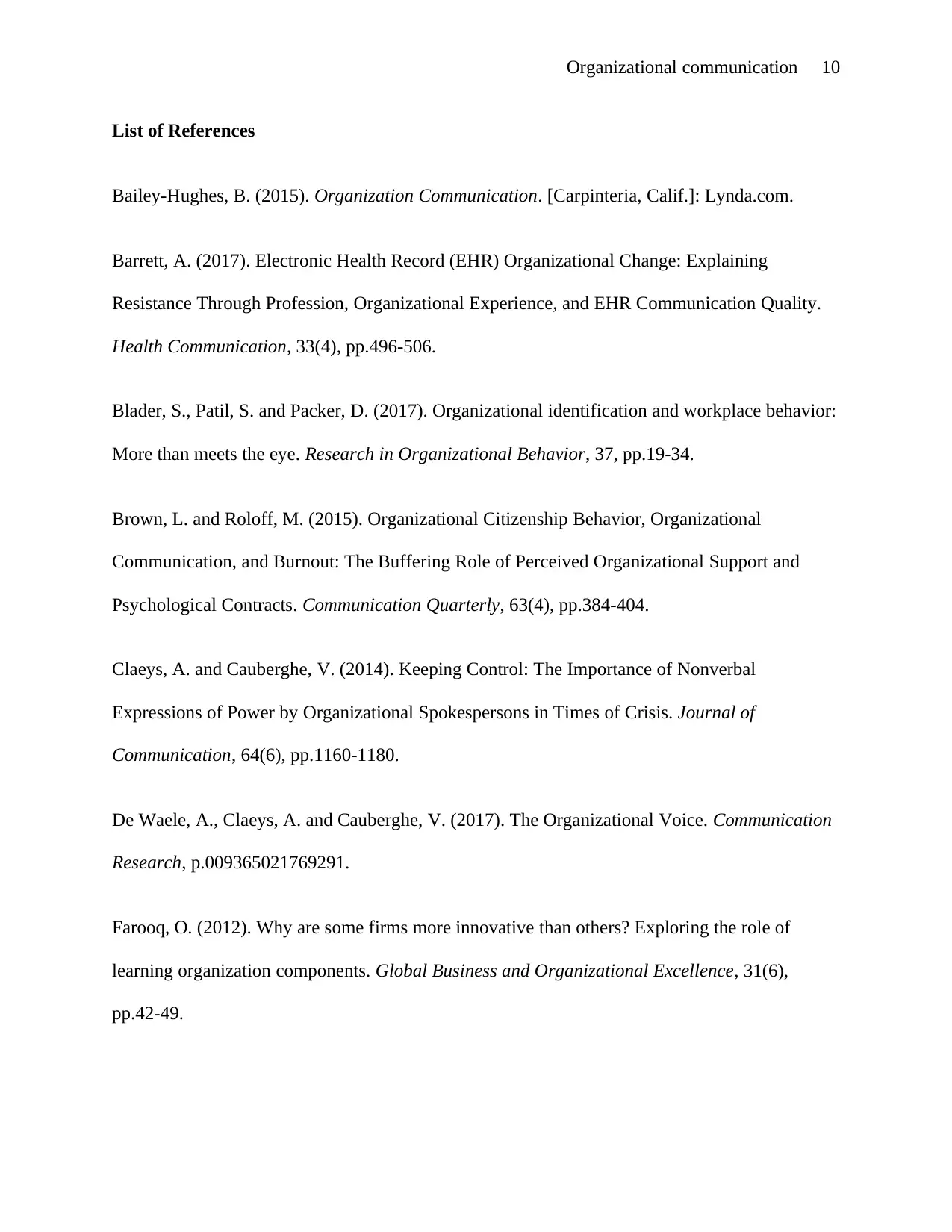
Organizational communication 10
List of References
Bailey-Hughes, B. (2015). Organization Communication. [Carpinteria, Calif.]: Lynda.com.
Barrett, A. (2017). Electronic Health Record (EHR) Organizational Change: Explaining
Resistance Through Profession, Organizational Experience, and EHR Communication Quality.
Health Communication, 33(4), pp.496-506.
Blader, S., Patil, S. and Packer, D. (2017). Organizational identification and workplace behavior:
More than meets the eye. Research in Organizational Behavior, 37, pp.19-34.
Brown, L. and Roloff, M. (2015). Organizational Citizenship Behavior, Organizational
Communication, and Burnout: The Buffering Role of Perceived Organizational Support and
Psychological Contracts. Communication Quarterly, 63(4), pp.384-404.
Claeys, A. and Cauberghe, V. (2014). Keeping Control: The Importance of Nonverbal
Expressions of Power by Organizational Spokespersons in Times of Crisis. Journal of
Communication, 64(6), pp.1160-1180.
De Waele, A., Claeys, A. and Cauberghe, V. (2017). The Organizational Voice. Communication
Research, p.009365021769291.
Farooq, O. (2012). Why are some firms more innovative than others? Exploring the role of
learning organization components. Global Business and Organizational Excellence, 31(6),
pp.42-49.
List of References
Bailey-Hughes, B. (2015). Organization Communication. [Carpinteria, Calif.]: Lynda.com.
Barrett, A. (2017). Electronic Health Record (EHR) Organizational Change: Explaining
Resistance Through Profession, Organizational Experience, and EHR Communication Quality.
Health Communication, 33(4), pp.496-506.
Blader, S., Patil, S. and Packer, D. (2017). Organizational identification and workplace behavior:
More than meets the eye. Research in Organizational Behavior, 37, pp.19-34.
Brown, L. and Roloff, M. (2015). Organizational Citizenship Behavior, Organizational
Communication, and Burnout: The Buffering Role of Perceived Organizational Support and
Psychological Contracts. Communication Quarterly, 63(4), pp.384-404.
Claeys, A. and Cauberghe, V. (2014). Keeping Control: The Importance of Nonverbal
Expressions of Power by Organizational Spokespersons in Times of Crisis. Journal of
Communication, 64(6), pp.1160-1180.
De Waele, A., Claeys, A. and Cauberghe, V. (2017). The Organizational Voice. Communication
Research, p.009365021769291.
Farooq, O. (2012). Why are some firms more innovative than others? Exploring the role of
learning organization components. Global Business and Organizational Excellence, 31(6),
pp.42-49.
Secure Best Marks with AI Grader
Need help grading? Try our AI Grader for instant feedback on your assignments.
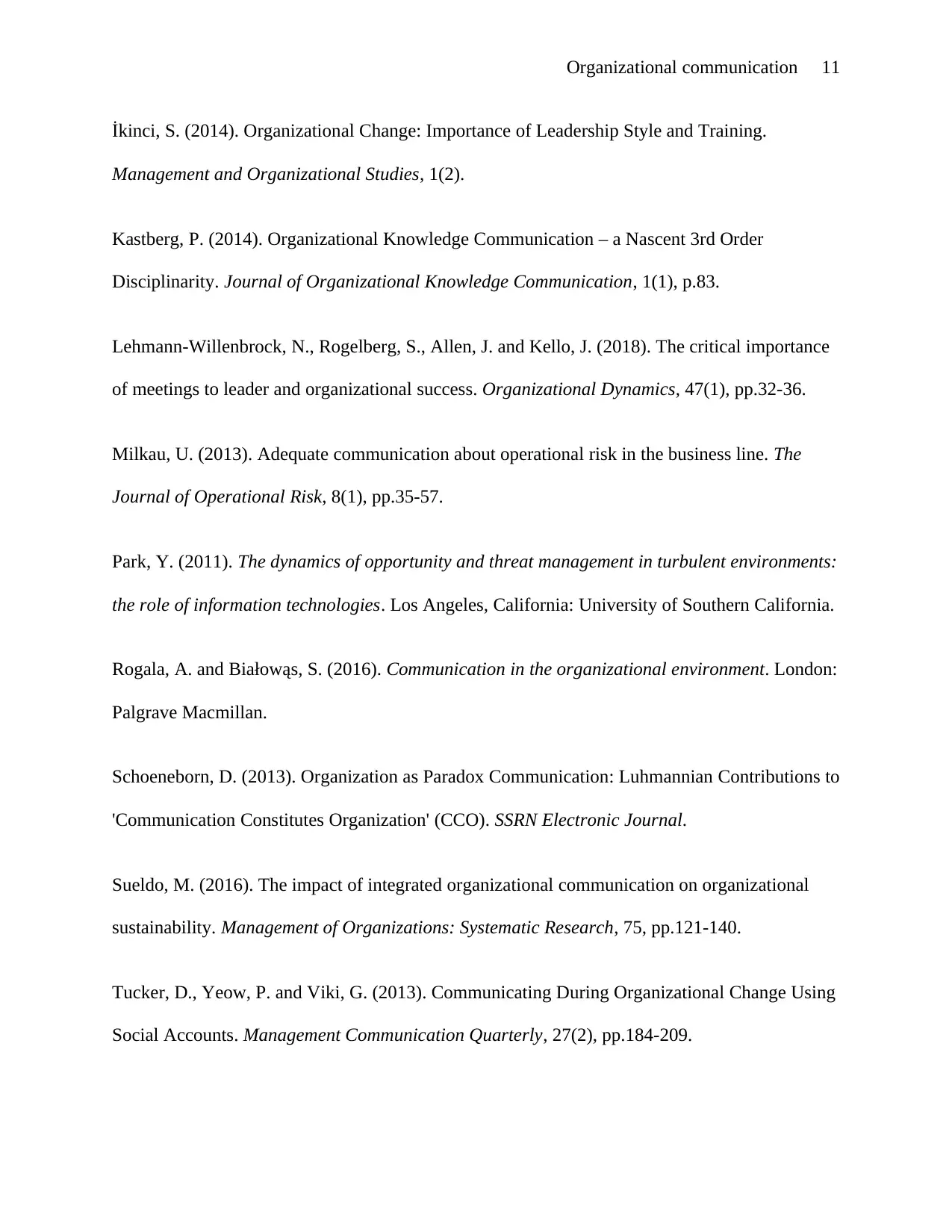
Organizational communication 11
İkinci, S. (2014). Organizational Change: Importance of Leadership Style and Training.
Management and Organizational Studies, 1(2).
Kastberg, P. (2014). Organizational Knowledge Communication – a Nascent 3rd Order
Disciplinarity. Journal of Organizational Knowledge Communication, 1(1), p.83.
Lehmann-Willenbrock, N., Rogelberg, S., Allen, J. and Kello, J. (2018). The critical importance
of meetings to leader and organizational success. Organizational Dynamics, 47(1), pp.32-36.
Milkau, U. (2013). Adequate communication about operational risk in the business line. The
Journal of Operational Risk, 8(1), pp.35-57.
Park, Y. (2011). The dynamics of opportunity and threat management in turbulent environments:
the role of information technologies. Los Angeles, California: University of Southern California.
Rogala, A. and Białowąs, S. (2016). Communication in the organizational environment. London:
Palgrave Macmillan.
Schoeneborn, D. (2013). Organization as Paradox Communication: Luhmannian Contributions to
'Communication Constitutes Organization' (CCO). SSRN Electronic Journal.
Sueldo, M. (2016). The impact of integrated organizational communication on organizational
sustainability. Management of Organizations: Systematic Research, 75, pp.121-140.
Tucker, D., Yeow, P. and Viki, G. (2013). Communicating During Organizational Change Using
Social Accounts. Management Communication Quarterly, 27(2), pp.184-209.
İkinci, S. (2014). Organizational Change: Importance of Leadership Style and Training.
Management and Organizational Studies, 1(2).
Kastberg, P. (2014). Organizational Knowledge Communication – a Nascent 3rd Order
Disciplinarity. Journal of Organizational Knowledge Communication, 1(1), p.83.
Lehmann-Willenbrock, N., Rogelberg, S., Allen, J. and Kello, J. (2018). The critical importance
of meetings to leader and organizational success. Organizational Dynamics, 47(1), pp.32-36.
Milkau, U. (2013). Adequate communication about operational risk in the business line. The
Journal of Operational Risk, 8(1), pp.35-57.
Park, Y. (2011). The dynamics of opportunity and threat management in turbulent environments:
the role of information technologies. Los Angeles, California: University of Southern California.
Rogala, A. and Białowąs, S. (2016). Communication in the organizational environment. London:
Palgrave Macmillan.
Schoeneborn, D. (2013). Organization as Paradox Communication: Luhmannian Contributions to
'Communication Constitutes Organization' (CCO). SSRN Electronic Journal.
Sueldo, M. (2016). The impact of integrated organizational communication on organizational
sustainability. Management of Organizations: Systematic Research, 75, pp.121-140.
Tucker, D., Yeow, P. and Viki, G. (2013). Communicating During Organizational Change Using
Social Accounts. Management Communication Quarterly, 27(2), pp.184-209.
1 out of 11
Related Documents
Your All-in-One AI-Powered Toolkit for Academic Success.
+13062052269
info@desklib.com
Available 24*7 on WhatsApp / Email
![[object Object]](/_next/static/media/star-bottom.7253800d.svg)
Unlock your academic potential
© 2024 | Zucol Services PVT LTD | All rights reserved.




